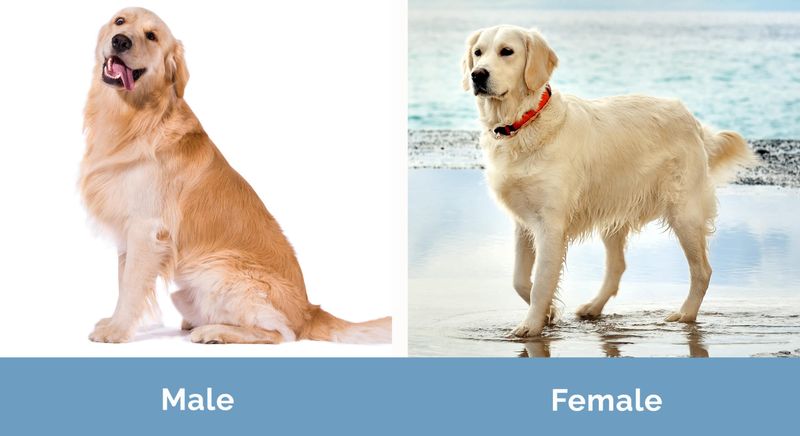Adopting a dog is a joyous occasion, but the choice between a male and female dog can be crucial for a harmonious household. Male and female dogs exhibit various differences that can affect your lifestyle and the dog’s well-being. From physical attributes to behavioral tendencies, understanding these nuances is essential for prospective pet owners. This guide delves into 12 key differences to consider before making your decision. Each difference is presented in a unique light, providing engaging, varied insights to help you make an informed choice. Explore these distinctions to find the perfect canine companion for you.
Physical Size and Build
Male dogs often boast a sturdier build compared to females. In various breeds, this difference is stark, with males being larger and heavier. Such physical traits make them appear more dominant. Interestingly, female dogs, while generally smaller, can exhibit a surprisingly fierce spirit, making up in personality what they lack in size.
For those looking for a more manageable pet, size can be a decisive factor. However, a smaller female dog may require less space and resources, making them ideal for apartment living or smaller homes.
Territorial Behavior
Ever wonder why your male dog insists on marking every lamppost? Male dogs are naturally territorial and often mark areas to assert dominance. This behavior can be minimized with proper training but tends to be more pronounced in males.
Female dogs are generally less territorial, focusing more on the household’s interior. They become fiercely protective, especially when it comes to their human family. This nurturing instinct makes them excellent watchdogs in family environments, though less inclined to roam.
Understanding these behaviors helps in curbing unwanted marking or wandering.
Aggression Levels
Aggression is often a concern for potential dog owners. Male dogs, especially unneutered ones, can exhibit higher aggression levels, particularly towards other males. This aggression is usually about dominance or territory.
Female dogs, while also capable of aggression, often display it in different contexts, such as protecting their young or family. With proper socialization and training, aggression can be managed in both sexes.
Ultimately, understanding and addressing these behaviors ensures a peaceful coexistence, allowing the dog’s true, loving nature to shine through.
Training and Obedience
When it comes to training, female dogs often have the edge. Many owners find them more focused and eager to please. This attentiveness can make obedience training smoother and more efficient.
Conversely, male dogs might exhibit a stubborn streak, testing boundaries more frequently. While this can pose challenges, it also presents opportunities for patient owners to develop strong leadership roles, forging a deep bond.
Regardless of gender, consistent training and positive reinforcement pave the way for a well-mannered, happy canine companion.
Energy Levels
An energetic dog can be a delight or a handful. Male dogs often exhibit hyperactive behaviors, requiring more exercise and playtime. This energy level can be ideal for active families or individuals who enjoy outdoor activities.
Female dogs, on the other hand, may display a more balanced energy, shifting between active and calm. This adaptability can make them suitable for varied lifestyles.
Understanding these tendencies allows potential owners to choose a dog that aligns with their activity level, ensuring a harmonious and fulfilling relationship.
Health Concerns
Health considerations are vital when choosing a pet. Male dogs, while robust, can be prone to specific conditions like prostate issues, especially if unneutered. Regular vet check-ups and preventive care are crucial.
Female dogs face their challenges, such as uterine infections or mammary tumors, particularly in unspayed females. These concerns can often be mitigated through spaying.
Understanding the health predispositions of each gender enables owners to take proactive steps in maintaining their pet’s well-being, ensuring a long, happy life together.
Affection Levels
Affection levels can differ significantly between male and female dogs. Male dogs often seek constant attention, displaying overt affection towards their human companions. They thrive on interaction and snuggling.
Female dogs tend to be more independent, offering affection on their terms. This independence doesn’t equate to aloofness; rather, it reflects a reserved yet deep bond with their family.
Recognizing these differences can help potential owners find a pet that matches their emotional needs, creating a loving and nurturing environment for both.
Life Span
Did you know? Female dogs often outlive their male counterparts. Studies suggest that females, especially when spayed, enjoy longer lifespans, potentially due to hormonal differences and health factors.
While lifespan varies among breeds, this trend is noteworthy for those considering long-term companionship. Male dogs, though equally cherished, may face earlier age-related issues.
Understanding these lifespan trends helps potential dog owners prepare for the future, ensuring they can provide the best care throughout every life stage. It’s about cherishing every moment together.
Grooming Needs
Grooming is an essential aspect of dog care, and male and female dogs present distinct challenges. Male dogs might require more frequent grooming due to their robust play habits, often resulting in matted or tangled coats.
Female dogs, while typically neater, may still need regular grooming, especially during shedding seasons. Understanding these grooming needs ensures your pet looks their best, contributing to their overall health and happiness.
For potential owners, grooming considerations can influence breed and gender choices, aligning with their ability to commit to regular maintenance.
Socialization with Other Dogs
Socialization is crucial for a well-adjusted dog. Males often exhibit more confidence, jumping eagerly into group play. This assertiveness can sometimes lead to dominance struggles, requiring careful management.
Females, however, may approach social situations with caution, displaying a more discerning nature. While they can be just as social, they often select their canine friends with care, valuing quality over quantity.
Understanding these social tendencies helps owners foster positive interactions, ensuring their dog thrives in diverse environments and enriching their social lives.
Barking and Vocalization
Barking tendencies can vary between genders. Male dogs may bark more frequently, using vocalization to assert dominance or alert their owners to changes in their environment.
Female dogs tend to be more selective with their barking, often doing so when they perceive a real need or threat. This discerning nature results in a quieter home environment.
Recognizing these differences allows potential pet owners to choose a dog that fits their noise tolerance and lifestyle, creating a peaceful and harmonious home.
Breeding and Reproductive Behavior
Reproductive behavior is a significant consideration for dog owners. Female dogs experience heat cycles, which can influence behavior and require careful management if not spayed.
Male dogs, driven by instinct, may roam or exhibit mounting behaviors, especially around females in heat. Such tendencies can be mitigated through neutering and training.
Understanding reproductive behaviors is essential for responsible pet ownership, helping prevent unwanted litters and ensuring both the dog’s and the owner’s well-being.












